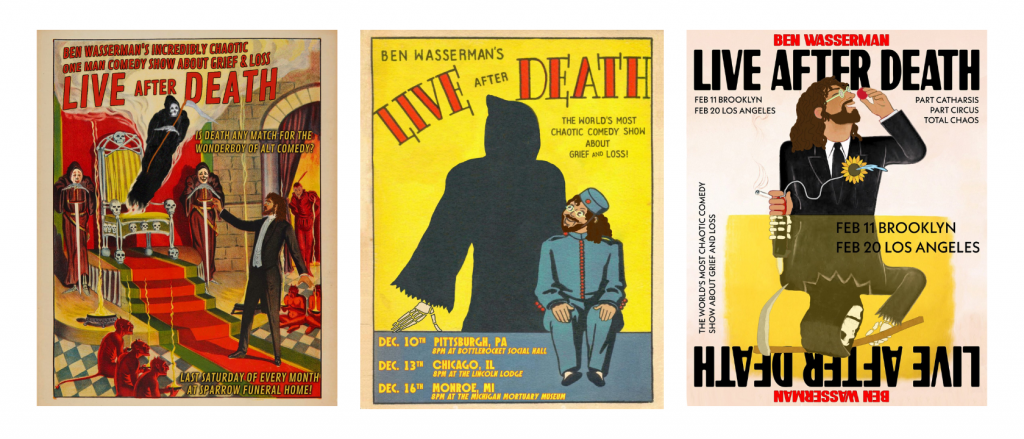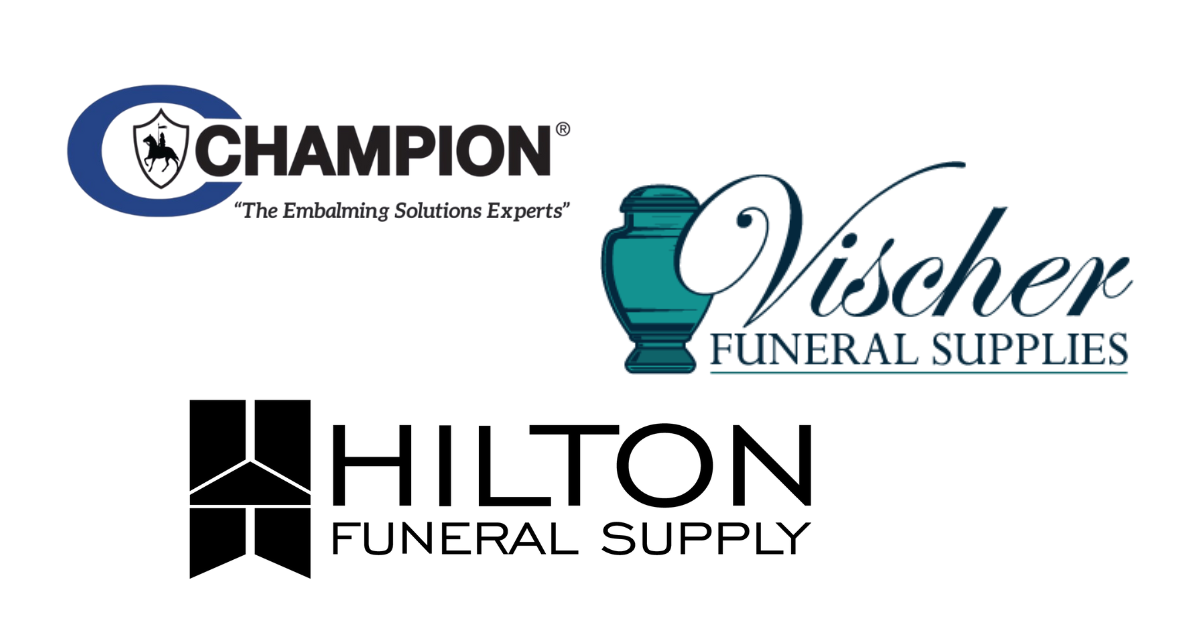For Ben Wasserman and his Surprising Audiences, Comedy is a Natural Way to Grieve
Is there a right way to grieve? A wrong way? A specific order to experience each phase — or a time limit to be done? Deathcare professionals know the answer to each of those questions is a resounding, “No.” The grief we endure, how long we suffer with it, and the ways we deal with it are infinitely varied. What works for one person may not be a solution for another.
When Ben Wasserman lost three family members and four friends within a three year span, he dealt with it in a way that felt right for him: Through standup comedy.
“It felt like the most natural way for me to let my feelings of grief kind of come out,” Wasserman, a professional comedian based in New York City, explained. “I had to let it come through in my performances and stage work.”
Wasserman’s comedic coping mechanism eventually developed into a standalone show he cleverly dubbed Live After Death, which he describes as a blend of “comedy, clowning, and crowd work” that “leads the audience on a hilarious yet moving journey through grief, honoring and celebrating the ones we’ve lost along the way.”
Cathartic and chaotic
You may wonder how exactly comedy fits in with something as serious and traditionally solemn as death. As it turns out, looking at death and grief through a comedic lens can be refreshingly cathartic — something you’ve probably already observed at some of the more enjoyable celebrations of life you’ve hosted.
“It’s not like people don’t laugh at funerals already,” Wasserman says. “There’s plenty of humor in eulogies. There’s plenty of laughter. So much of my own experience was lots of joking around and telling stories during Shiva with my family.”
With Live After Death, Wasserman’s first goal is to be respectful of the subject matter, the audience, and the deceased who are being honored. Wasserman understands the concerns of funeral directors and funeral home owners who may be wary of promoting a comedy show either on or off their deathcare premises.
“The only pushback I’ve received [when pitching the performance] is that the show has to be respectful, which I think is a reasonable concern of any funeral home or cemetery,” Wasserman explains. “The show requires transforming these spaces into ones where a performance or conversation can happen in a way that doesn’t usually happen, but also maintain the vibe of the funeral home, cemetery, or venue.”
“It’s allowing those spaces to exist both in these awful times of death and loss, but also to hold the space for what comes next, in the mourning, grief, and rest of life,” he continues. “The show isn’t there to make a mockery of death. It is a container to hold space for people to grieve, connect, feel less alone, and also laugh together.”

Grief group
Wasserman’s first Live After Death show took place in a New York funeral home at the invitation of Lily Sage Weinrieb, a funeral director and friend.
“[Ben’s show offers the] equivalent catharsis of a really great grief group,” Weinrieb says. “But doing so in an audience setting was so powerful, and I wanted him to be able to do that in a funeral home space because it is appropriate and it is funny. If it wasn’t good enough to be performed in front of families that I served, it wouldn’t have it come to my funeral home.”
Weinrieb has taken the opportunity to introduce Wasserman to the audiences who have gathered at her funeral home before the show begins, applauding them for stepping through the doors for something that can be unexpected in such a venue.
“Thank you for being brave enough to step into a funeral home, knowing that you are here for a reason that might not be what you’re typically here for,” she tells the audience, “and for taking the risk that is going to be to laugh, to cry, or to have some kind of feeling that you might not have walked in with.”
Weinrieb says she explains to the audience that the space is for the community, and the Live After Death show is a way the space can be used to challenge and comfort them. She was pleasantly surprised by the audience feedback on the topic following the first few shows.
“I had so many folks come up to me and say, ‘Oh my gosh, I can’t believe that this a funeral home and you’re doing this, and I feel so comfortable here, and I wish this had been around when my mom died,’” Weinrieb says. “I think that’s really powerful: the idea of creating feedback in a community that you’re there to serve. As a funeral home owner, you have an enormous amount of power in your community to bring these conversations to light.”
A surprising crowd
Neither Wasserman nor Weinrieb knew exactly who would be in the audience at those first few Live After Death shows, but both have been pleasantly surprised at the eclectic groups, which are growing with each new date.
“It’s really been fascinating to see the diversity of backgrounds in both demographics, what people do for a living, and why they’re there,” Wasserman explains. “It’s a really good mix of young and old people, widows, married couples, and people on a date night.”
One of the more interesting contingents in the audience has been the large number of deathcare professionals. Wasserman says he’s enjoyed meeting the embalmers, funeral directors, and death doulas who come out to enjoy Live After Death — and so have the other attendees.
“It’s an interactive show, so sometimes I check in and ask someone what they do for a living,” explains Wasserman. “When I learn that someone’s a mortician, I ask if we have any other funeral workers here. It’s been really fun seeing like eight people’s hands shoot up at any given show. And after the show, other people are coming up to talk to me and saying they didn’t realize there were so many morticians in the audience. It’s been a humanizing component for them.”
No matter who makes up the audience, Wasserman says, they all have one thing in common: they’ve lost someone for whom they cared.
“Everyone loses someone,” he explains. “Everyone has gone through the pain, and they have to contend with their grief in their own way. But I think that people who come to the show are mostly people who’ve lost someone in the last year or two, and they’re looking for a laugh or found out about the show through a grief group. And then just comedy fans, people who are looking for a good, fun night out because it’s a fun show. It’s very much about death and loss and grief and an attempt to honor the people who are still in our lives and ourselves through that journey. But at the same time, it’s a funny, entertaining show.”
Booking Ben
In 2022, Wasserman performed 15 Live After Death shows in various venues, from funeral home community spaces to a mortuary museum to a record store, but he’s open to bringing his event to new locations and interesting spots, like green burial cemeteries, crematory chapels, a casket factory, or deathcare expos. He’s already working with Gail Rubin, a.k.a. The Doyenne of Death®, to appear at her upcoming Before I Die Festival in New Mexico.
“It’s just a matter of finding a space where between 40 and 70 people can gather comfortably,” Wasserman explains. “I don’t need an event space. I can use a chapel or a celebration room. I just try to work and accommodate however I can with the space. My show packs and travels and is ready to go.”
Weinrieb hopes more deathcare professionals will learn of and ultimately experience Live After Death in their own facilities.
“The funeral home is the perfect space for a comedy show, especially one that deals intimately with topics of grief, death, and loss,” she explains. “It is not offensive. It is not gory. It is not chastising. It is not going to make you bury your head in shame in any way. I think that’s the ultimate fear that we have as funeral directors; we do have a reputation to uphold in our communities.”
“I can only encourage folks who have the power to invite Ben and his show into their space to just see this show, because what it actually does is lift you up. It does a good job of showing the partnership between Ben, the audience, and the people who can meet a family in these crazy and turbulent times and usher them through the doors of grief with confidence and humor and compassion.”
If you’d like to learn more about Live After Death or schedule a date to bring Ben Wasserman into your community, visit https://www.benwassermancomedy.com or email Ben at benwassermail@gmail.com.




